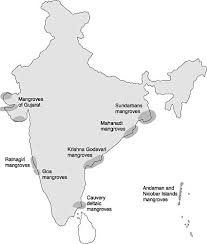Mangrove forests in India are an essential ecosystem found in India’s coastal regions. These forests are not only important for the environment but also for the economy and livelihoods of local communities. In this article, we will discuss the significance of mangrove forests in India, their current state, and the conservation efforts being undertaken to protect them.

Table of Contents
Significance of Mangrove Forests in India
Mangrove forests are unique ecosystems that are found in the intertidal zones of coastal areas. They are important breeding, spawning, and nursery grounds for a wide variety of marine and estuarine species. In India, these forests are found along the Bay of Bengal, the Arabian Sea, and the Andaman and Nicobar Islands. They are home to a rich biodiversity, including several species of birds, reptiles, and mammals.
Apart from their ecological significance, mangrove forests also have significant economic importance. They act as a buffer against natural disasters such as cyclones, floods, and tsunamis. They provide livelihood opportunities for communities living in and around them, including fishing, honey collection, and eco-tourism. Mangrove forests are also essential for carbon sequestration, helping to mitigate the effects of climate change.
Current State of Mangrove Forests in India
Despite their significance, mangrove forests in India are under threat from various human activities such as coastal development, aquaculture, and logging. The loss of these forests has led to a decline in biodiversity and the degradation of coastal ecosystems. According to a report by the Forest Survey of India, mangrove cover in the country has decreased by around 34% since the 1980s.
Conservation Efforts of Mangrove Forest in India
The Indian government has recognized the importance of mangrove forests and has taken various steps to conserve them. The National Mangrove Committee was set up in 1983 to monitor and coordinate conservation efforts. The government has also initiated various schemes and programs such as the Integrated Coastal Zone Management Program and the National Afforestation Program to promote afforestation and restore degraded mangrove areas.
Several non-governmental organizations are also working towards mangrove conservation in India. The Mangrove Foundation, for example, is working towards the restoration and conservation of mangrove forests in the state of Maharashtra. The organization has planted more than 200,000 mangrove saplings across several coastal areas in the state.
Conclusion
In conclusion, mangrove forests are vital ecosystems that play a crucial role in the environment, economy, and livelihoods of coastal communities in India. It is essential to recognize their importance and take concerted efforts towards their conservation. The government, along with NGOs and local communities, must work together to ensure the protection and restoration of mangrove forests for future generations.
Important Links